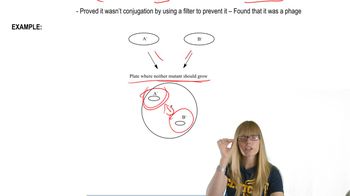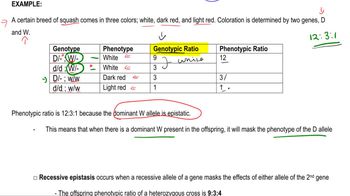The Hoxd9–13 genes are thought to specify digit identity. What would be the consequence of ectopically expressing Hoxd10 throughout the developing mouse limb bud? What about Hoxd11? What about both Hoxd10 and Hoxd11?
Table of contents
- 1. Introduction to Genetics51m
- 2. Mendel's Laws of Inheritance3h 37m
- 3. Extensions to Mendelian Inheritance2h 41m
- 4. Genetic Mapping and Linkage2h 28m
- 5. Genetics of Bacteria and Viruses1h 21m
- 6. Chromosomal Variation1h 48m
- 7. DNA and Chromosome Structure56m
- 8. DNA Replication1h 10m
- 9. Mitosis and Meiosis1h 34m
- 10. Transcription1h 0m
- 11. Translation58m
- 12. Gene Regulation in Prokaryotes1h 19m
- 13. Gene Regulation in Eukaryotes44m
- 14. Genetic Control of Development44m
- 15. Genomes and Genomics1h 50m
- 16. Transposable Elements47m
- 17. Mutation, Repair, and Recombination1h 6m
- 18. Molecular Genetic Tools19m
- 19. Cancer Genetics29m
- 20. Quantitative Genetics1h 26m
- 21. Population Genetics50m
- 22. Evolutionary Genetics29m
14. Genetic Control of Development
Developmental Patterning Genes
Problem 22b
Textbook Question
Vulval development in C. elegans is dependent on the response of some of the central epidermal progenitor cells in the region of the developing vulva to a chemical signal from the gonad. Signaling from the gonad is blocked by action of the vulvaless mutant let-23 so that none of the central progenitor cells form vulval structures. In the vulvaless mutant, n300, the central progenitor cells do not form.
What phenotype (vulva formed or vulvaless) would you expect from the double mutant? Why?
 Verified step by step guidance
Verified step by step guidance1
Step 1: Understand the role of the let-23 gene in vulval development. The let-23 gene encodes a receptor that is necessary for the epidermal progenitor cells to respond to the chemical signal from the gonad, which induces vulval formation.
Step 2: Recognize that in the let-23 vulvaless mutant, signaling from the gonad is blocked, so the central epidermal progenitor cells are present but do not receive the signal to form vulval structures, resulting in a vulvaless phenotype.
Step 3: Understand the n300 mutant phenotype, where the central epidermal progenitor cells themselves do not form. This means there are no cells available to respond to the gonadal signal or to form vulval structures.
Step 4: Consider the double mutant combining let-23 and n300 mutations. Since n300 causes the absence of the progenitor cells, even if let-23 function were restored, there would be no cells to respond to the signal or form vulval structures.
Step 5: Conclude that the double mutant would exhibit a vulvaless phenotype because the absence of progenitor cells (due to n300) is epistatic to the signaling defect caused by let-23, meaning the lack of cells overrides the signaling pathway defect.
 Verified video answer for a similar problem:
Verified video answer for a similar problem:This video solution was recommended by our tutors as helpful for the problem above
Video duration:
3mPlay a video:
Was this helpful?
Key Concepts
Here are the essential concepts you must grasp in order to answer the question correctly.
Signal Transduction in Vulval Development
Vulval development in C. elegans depends on a chemical signal from the gonad that activates central epidermal progenitor cells. This signal is received and processed through a pathway involving the let-23 gene, which encodes a receptor tyrosine kinase essential for initiating vulval cell fate. Disruption of this signaling prevents vulval formation.
Recommended video:
Guided course

Transduction
Function of the let-23 Gene and Vulvaless Phenotype
The let-23 gene encodes a receptor required for the gonadal signal to induce vulval development. Mutations in let-23 block this signal, causing a vulvaless phenotype where progenitor cells fail to form vulval structures despite their presence. This highlights let-23’s role in signal reception rather than progenitor cell formation.
Recommended video:
Guided course

Functional Genomics
Genetic Epistasis and Double Mutant Analysis
Double mutant analysis helps determine gene order and function by observing phenotypes when two mutations coexist. If one mutation (n300) causes absence of progenitor cells and the other (let-23) blocks signaling, the phenotype of the double mutant reveals which gene acts upstream or downstream, clarifying the developmental pathway.
Recommended video:
Guided course

Epistatic Genes
Related Videos
Related Practice
Textbook Question
663
views


